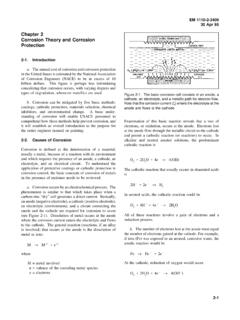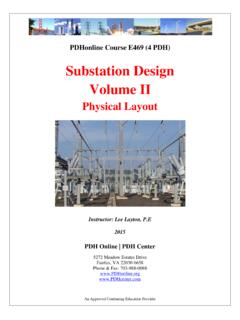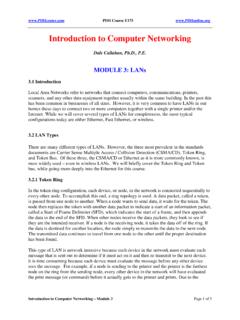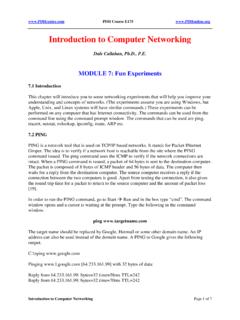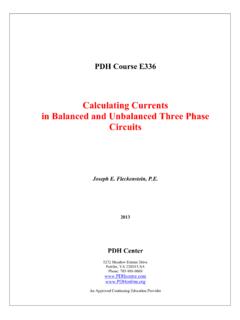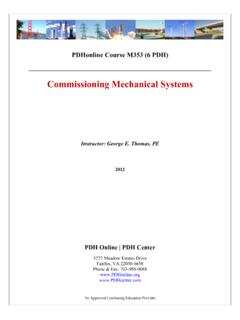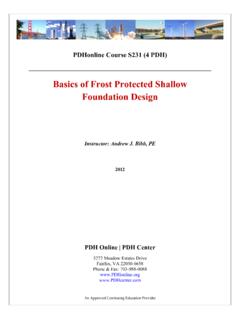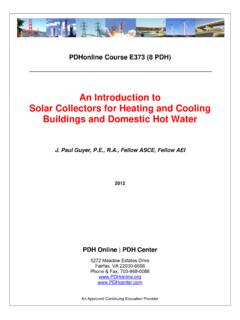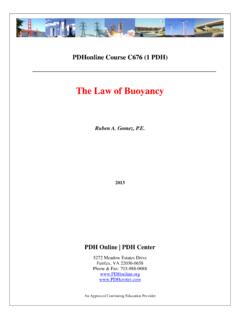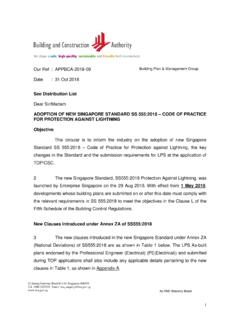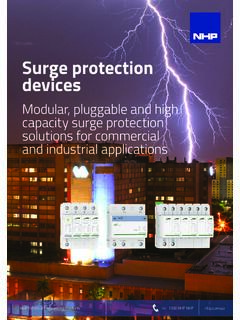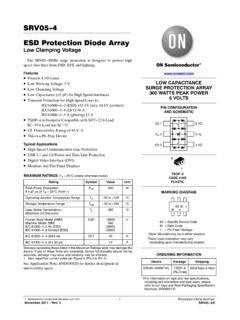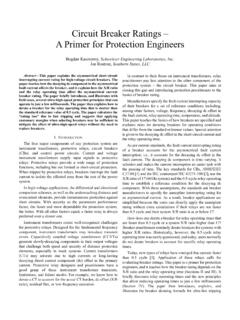Transcription of Designing to Lightning Standard, NFPA-780-2011
1 PDHonline Course E367 (2 PDH) Designing to Lightning Standard, nfpa -780-20112012 Instructor: Thomas Mason, Online | PDH Center5272 Meadow Estates DriveFairfax, VA 22030-6658 Phone & Fax: Approved Continuing Education PDH Course E367 Designing to Lightning Standard, nfpa 780-2011 Thomas Mason, PE The goal of this course is to learn how to design Lightning protection systems. Fortunately, it is very easy. Please consider the following four examples: This illustration is for orientation. This illustration identifies the components and introduces the basic rules for an nfpa 780-2011 Lightning protection system. To the left are the air terminals, conductors, supports, and ground rods. To the right are electric power service components which are essential to Lightning protection .
2 If they do not already exist, they must be added at the time of Lightning rod installation. Note especially the intersystem bonding terminal and surge protective device (SPD). The equilization bonding conductor is part of the Lightning protection system. IEEE says that you must place an additonal surge protective device at each critical, sensitive equipment, such as television, personal computer and microwave. Thomas Mason Page 2 of 18 PDH Course E367 Why is this course organized this way and what is this box and who cares about IEEE ? First, the box. This course contains hard content, as materials requirements, minimum and maximum dimensions, counts and spacing. It also contains asides, interesting useful information that is not central to complying with the Standard. Such asides will be placed in boxes like this, called sidebars, to offer the opportunity to skip them completely, if you wish.
3 Now, regarding the examples. To convince you that this course provides immediate value in your job, we are giving examples of the product we promise to deliver. If you wanted to learn to do calculations or fill out requirements forms, this is the wrong course. We will refer to our examples to show how to apply the hard content. Regarding additional surge protective devices and IEEE recommendations. nfpa 780 requires a surge protective device (SPD) at the electric power service. It recommends additional downstream SPD at branch panels (commercial and industrial) and at critical sensitive equipment. The IEEE Emerald Book, dedicated to protecting equipment from surges, requires SPD at the critical, sensitive device and recommends upstream SPD at the branch panel and at the service. If your goal is to protect the structure and its contents, do put in more than the minimum SPD.
4 (And that does not mean you should buy a premium single unit. It means you should buy multiple good units.) Referring to the illustration, Ridge protection , Less than 75-ft, Corner Downcomer, let us examine each detail. First, the title, Ridge protection . We normally think of Lightning as coming down from the sky, so the highest point on the structure has the most exposure. And, normally this is correct. The ridge is the line along the top of the roof, sticking up highest into the sky. This is correct placement only as first approximation. There is a very common circumstance in which a storm front rapidly approaches. You can see the clouds coming at you. Sometimes, you can see an actual edge of the rain approach. What you don t see is the change is the electric charge coming at you. This is easily measurable, using high school physics laboratory equipment (gold leaf electrometer or electronic equivalent).
5 As the charge front approaches, it is common to get a side flash to the gutters of a building or to the extended branches of a tree. The intuitive approach would say, That is only a few moments in a thunderstorm that can last for hours or days. It can t be much of a statistical hazard. Wrong. Just driving around, you can see the soot, damaged masonry and crispy branches, usually about midway up the tree, with a clear path to the main stalk and down to the trunk. Ridge protection is the first line of defense, but perimeter protection is a close follow-up, and the normal protection for commercial and industrial structures. Thomas Mason Page 3 of 18 Back to the illustration. Less than 75-ft distinguishes tall structures from short structures, within the PDH Course E367 definition by nfpa .
6 There are three differences between less than 75-ft and more than 75-ft, as follows: nfpa 780 2011 Item Less than 75 ft More than 75 ft Name Class I Class II Air Terminal min 3/8 in dia min 1/2 in dia Main / Downcomer 57 kcmil (between #2 and #3 AWG) 115 kcmil (between 1/0 and 2/0) Earthing Rods Rods and Loop Corner Downcomer introduces two critical concepts - earth potential and current dissipation. Earth potential is the voltmeter reading between where you are measuring and remote earth. It is non-intuitive, but the local value of ground changes by several hundred volts as a storm approaches and passes over. Why do you say that local ground value changes ? I could cite publications, but I would rather cite personal experience. In the 1980 s I was tech support for a large petrochemical research facility. As we kept building more laboratories, we kept extending our RS-232 data network (the best available at that time).
7 When the runs exceeded 500-lf, we started blowing RS-232 receiver chips. RS-232 is defined as +12, -5 V pulses, 1200bps to 56kbps (personal computers use +5, 0 V, but that is another story). The OEM receiver chips were rated to 50 V input. After many, many failures of these chips, we found a 300 V input chip that was a pin-for-pin replacement. Today, we would use opto-isolators and surge protective devices. As part of troubleshooting the RS-232 problem, I lifted ground leads and saw them spark and measured 50-100 VDC with a digital meter, but 0 VDC with a Simpson analog meter. It was high voltage with tiny current. On the other hand, I have seen the #22 AWG ground wires burned off, probably associated with a nearby strike rather than a ground shift. Current dissipation is what happens when the Lightning rods does its duty. A current of 50,000 500,000A (short duration) will travel across the main, use the downcomer and ground rod.
8 From the ground rod, it dissipates into the contacting earth. This subject has been extensively researched for high-voltage electric substation faults. Those longer duration current flows create a lethal voltage, or step potential at the point of entry to the earth, which diminishes exponentially as you move away from the point of entry. For Lightning current dissipation, the massive current flow boils the moisture at the rod and it expands away from the rod. The earth adjacent to the rod is now dry and non-conductive. Between the two, differing ground potentials and no-longer-functional ground rods, you can see why it is required to have a minimum of two ground rods and they should be placed as far from each other as possible. Thomas Mason Page 4 of 18 PDH Course E367 But not far from the building.
9 The ideal position of the ground rod is at the downcomer, 24-30-in from the foundation. More distance is bad. Lightning is very quirky. Three characteristics should be introduced immediately - it doesn t like to go up; it doesn t like to go far; and, it does what it wants to do regardless of what you do. You will note that I am anthropomorphizing. After a while, people who study Lightning start to do that. The laws of high school physics and undergraduate electrical engineering work only grossly with Lightning . NASA is still having a hard time figuring when they dare fire off a rocket and when it would be better to wait. We put in a nice, thick copper downcomer and the Lightning jumps off the side to the brick building, runs a few feet, then jumps back on the downcomer. This has been repeatedly observed and photographed. The soot stains and cracked masonry remain.
10 Let us review the notes on the Corner Downcomer illustration. The first two say, Never go up with main or branch conductor and Minimum radius 8-in with a minimum 90-degree bend. The never-go-up is my inference from examples later in nfpa -80 on right and wrong installation of branch conductors on dormers. It matches my intuition for the phenomenon, as a current flow trying to equalize the voltage from the bottom of the cloud to the earth. There is a voltage gradient. The flow is trying to follow the gradient. The forces involved are against contra-gradient flow. The rule to keep sweeping bends and not too sharp is clearly stated in the Standard. Again, this matches my mental picture of the driving voltage gradient and the current flow. A sharp bend or an acute bend will have the leading edge of the flow fighting the trailing edge. Photographs and soot marks indicate where lighting jumps off the downcomer because the bend was too tight.
